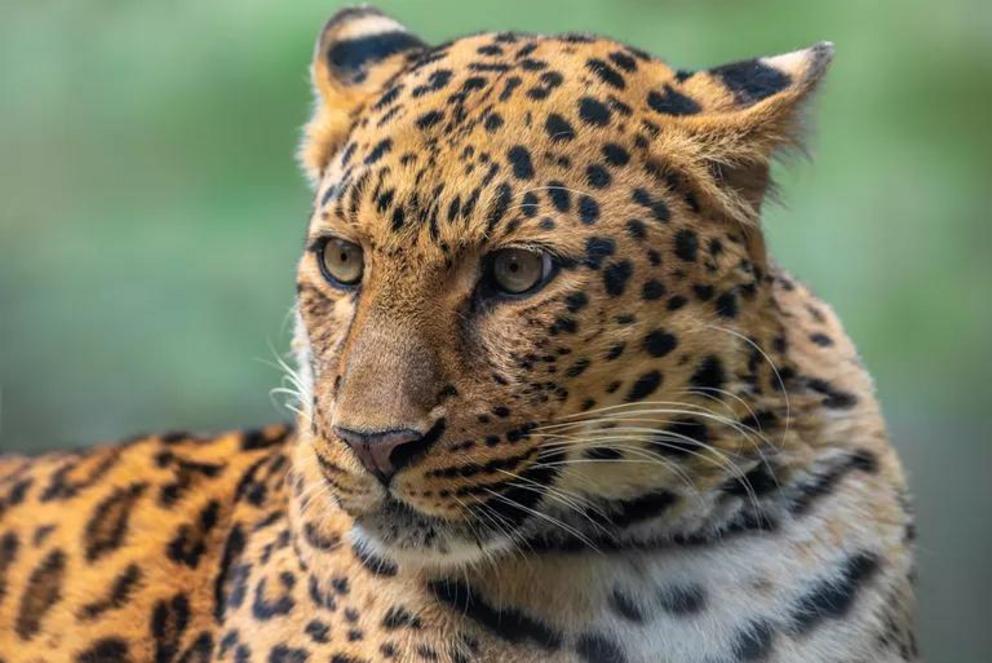Leopard population in northern China is on the rise
Amur leopards are found in northern China and the Russian Far East.
Researchers were surprised at their resilience.
The Amur leopard looks and acts like most other leopards. Native to the Russian Far East and northern China, it has a distinctive spotted coat, runs incredibly fast, and leads a mostly solitary life. However, unlike many of its big cat counterparts, this leopard isn’t facing critical population declines. The number of Amur leopards is increasing in Northern China, according to a new study.
“All subspecies of leopards have decreased fast for the past few decades. The North Chinese leopard is not an exception, having disappeared from most of their historical ranges,” co-author Bing Xie, a PhD student in the University of Copenhagen's Department of Biology, tells Treehugger.
"We were quite surprised that the number of leopards has increased, because their populations are declining in many other places. We knew that there were leopards in this area, but we had no idea how many.”
For the study, which was published in Integrative Zoology, researchers from the University of Copenhagen and Beijing Normal University covered 800 square kilometers of the Loess Plateau in northern China between 2016 and 2017 looking for the Amur leopard (Panthera pardus orientalis aka Panthera pardus japonensis). They set camera traps to not only record leopard visits, but also to watch for prey and human activity.
“We saw leopards in videos, rarely in the field. But we did find lots of signs in the field, such as scratches, furs, footprints, and [scat],” she says. “I was once very close to a leopard on a mountain, but I was the last one in a line of three people, and the leopard just left comfortably before I reached close enough.”
Researchers found that the number of leopards rose from 88 in 2016 to 110 in 2017 — a 25% increase. The largest population was found in the forests in the central Loess plateau and the density of leopards was higher than in other areas of China.
The critically endangered cat faced extinction in 2007, with just 30 animals counted in Russia, according to the World Wildlife Fund (WWF). But a 2015 census found that the Amur leopard's population had started to mend with 57 cats counted in Russia’s Land of the Leopard National Park and 8 to 12 counted in China.
“Such a strong rebound in Amur leopard numbers is further proof that even the most critically endangered big cats can recover if we protect their habitat and work together on conservation efforts” said WWF conservation director Barney Long in a statement at the time. “There’s still a lot of work to be done in order to secure a safe future for the Amur leopard, but these numbers demonstrate that things are moving in the right direction.”
Reasons for the Rebound
Researchers suspect there are several factors that contribute to the leopard’s population rise. The Chinese government worked with scientists to put a plan in place in 2015 to restore biodiversity to the area. As the habitat flourished, smaller animals returned.
“Together with development of society, supported by the government, and efforts of researchers, forests recovered, followed by recovery of prey species of leopard, and then the top predator came back, the North Chinese leopard,” Xie says.
Most leopard species populations are struggling. A comprehensive report published in 2016 in the journal PeerJ found that the leopard now occupies 25–37% of its historic range
The International Union for Conservation of Nature (IUCN) changed its Red List status for the leopard from near threatened to the more serious “vulnerable” in 2016. The change was made based on loss of habitat and prey, as well as exploitation of the species.
The Amur leopard is one of nine subspecies found in Africa and Asia. Leopard populations have been affected by habitat fragmentation, human activity, availability of prey, and other threats, according to the IUCN.
"That 98 percent of leopard habitat has been lost over the years makes me so sad,” Xie said in a statement. “I have a great love for these gorgeous cats and I will continue to research on how best to protect them.”

